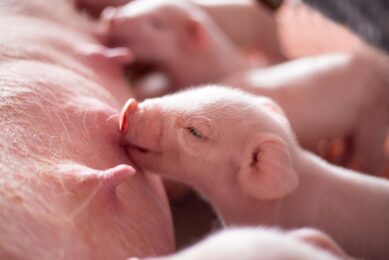Colostrum (I): Hand management

Pig Progress’s expert, John Gadd, takes a look at colostrum. There are many that would think there is little more left to say about colostrum – so why raise the subject? On the contrary things postnatally are changing fast. John explains.
EXPERT
We know it is vital to provide maternal immunogens to bridge the gap before the neonate acquires its own immunity. And that this must be done quickly within 12 to 18 hours before the gut closes to these large molecules. So what’s new – if anything?
What is new is that things postnatally are changing fast. Larger litters have arrived with the inevitable last to be born short of energy reserves and short of oxygen, solely because they have had to wait so long to be born. Remember Dr Peter English’s prophetic statement of 20 years back ‘A piglet starts to die as soon as the birth process commences’. With litters of 12 to 14 happily more common today, there are bound to be more of these late arrivals. The queue is longer.
A search through several nation’s records suggest that there seems to be no more born-deads than before (where they are recorded, which is not that often), but there is a significant rise in mortalities to weaning. For 30 years as a farm advisor I battled with 12% mortality to weaning (1.4 pigs per litter), and never seemed to get it down all that much, when today I come across 15% and occasionally 18%, (upwards of 2.1 pigs lost per litter). Rather surprisingly this can get a phlegmatic response of, “Well, I’m still getting about one more weaned with these new genetics, despite the higher pre-weaning losses.”
Wise words
This set me thinking as I always listen to what experienced farmers tell me. Looking back over my (and some others) clientele who were achieving 6% or less with the new hyperprolifics, losing 1 pig/litter and managing to get 13 of them to slaughter when 15 years ago they struggled to get 11 to market from a litter. So I tried to ascertain how they do it?
‘Hand management’
My term for assiduous attention to the newborn piglet, especially those increasing numbers of ‘late arrivals’.
- A few with no women in the farrowing barn were using prostaglandins (apparently knowing how to get them) so they could be there at farrowing, and 2 large units ran a night shift. These found little difficulty in breaking the 6% barrier seemingly from this alone. They made sure the neonates go immediately they were dried off (hand management) to a teat, as even healthy first-borns can take 15 minutes to start suckling on their own.
- Many felt that everybody talks about the importance of immunogens in colostrum, but ensuring the pigs get the special type of energy in colostrum is just as important. Much closer attention was accorded to the weaker arrivals. The really bad ones, from really wobbly to flaccid, were stomach-tubed (hand management) or warm water bathed with a flotation collar (hand management) then plugged into a forward teat (it is suggested they have better quality, or more, immunoglobulins) with the litter temporarily removed out of the way to a haybox (hand management again).
- A firm belief running through most of the experienced stockpersons (who from their experience of what works, I found wise and far-seeing) was that an energy supply within the first few minutes was a key factor in saving lives for the tail-enders and providing a better start for everybody. “Just as important as those immunoglobulins everyone goes on about,” several said. The neonate is at 38°C in the birth canal and, if it is lucky, arrives into 30°C once delivered, which even at that temperature quickly burns up what energy it is born with. So that’s why so many get crushed – not a clumsy sow or a poorly designed crate or too rough a floor, but hypoglycaemia (low blood sugar). The first suckle is as important to refuel its very meagre energy reserves as to provide acquired immunity.
Hand management depends on time
When buying or selling a domestic dwelling the realtor or estate agent’s mantra has long been ‘location, location, location’. In the baby pig’s case it is ‘time, time, time’. Time to spend on hand management. I published a survey on this ten years ago which suggested that, on average, breeders spent only 8% on the baby pig. Not nearly enough.
In the next edition I will expand on the immunological position as it is today and provide some payback figures easily offsetting the cost of good hand management.











